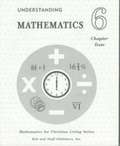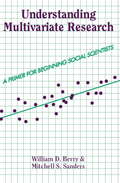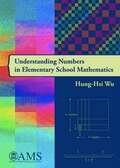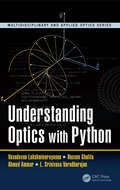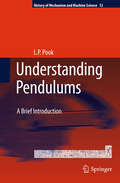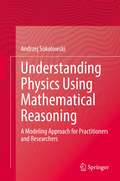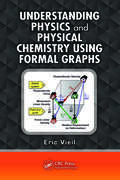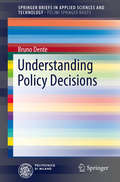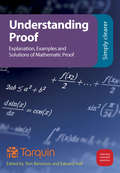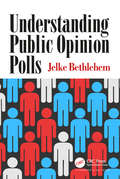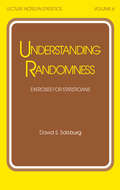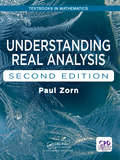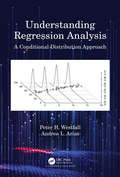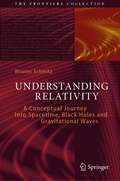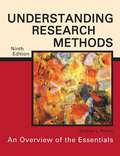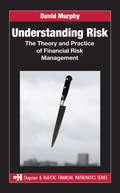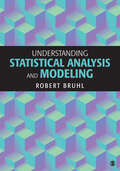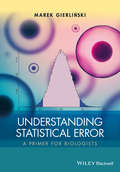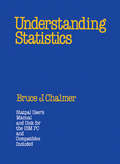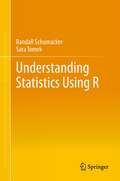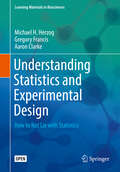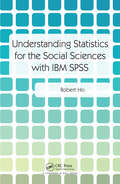- Table View
- List View
Understanding Mathematics: Grade 6 Chapter Tests (Mathematics for Christian Living Series)
by Rod Staff Publishers StaffContains chapter tests with plenty of problem solving illustrations.
Understanding Multivariate Research
by William Berry Mitchell SandersAlthough nearly all major social science departments offer graduate students training in quantitative methods, the typical sequencing of topics generally delays training in regression analysis and other multivariate techniques until a student’s second year. William Berry and Mitchell Sanders’s Understanding Multivariate Research fills this gap with a concise introduction to regression analysis and other multivariate techniques. Their book is designed to give new graduate students a grasp of multivariate analysis sufficient to understand the basic elements of research relying on such analysis that they must read prior to their formal training in quantitative methods. Berry and Sanders effectively cover the techniques seen most commonly in social science journals--regression (including nonlinear and interactive models), logit, probit, and causal models/path analysis. The authors draw on illustrations from across the social sciences, including political science, sociology, marketing and higher education. All topics are developed without relying on the mathematical language of probability theory and statistical inference. Readers are assumed to have no background in descriptive or inferential statistics, and this makes the book highly accessible to students with no prior graduate course work.
Understanding Numbers in Elementary School Mathematics
by Hung-Hsi WuThis is a textbook for pre-service elementary school teachers and for current teachers who are taking professional development courses. By emphasizing the precision of mathematics, the exposition achieves a logical and coherent account of school mathematics at the appropriate level for the readership. Wu provides a comprehensive treatment of all the standard topics about numbers in the school mathematics curriculum: whole numbers, fractions, and rational numbers. Assuming no previous knowledge of mathematics, the presentation develops the basic facts about numbers from the beginning and thoroughly covers the subject matter for grades K through 7. Every single assertion is established in the context of elementary school mathematics in a manner that is completely consistent with the basic requirements of mathematics. While it is a textbook for pre-service elementary teachers, it is also a reference book that school teachers can refer to for explanations of well-known but hitherto unexplained facts. For example, the sometimes-puzzling concepts of percent, ratio, and rate are each given a treatment that is down to earth and devoid of mysticism. The fact that a negative times a negative is a positive is explained in a leisurely and comprehensible fashion.
Understanding Optics with Python (Multidisciplinary and Applied Optics)
by Ahmed Ammar Vasudevan Lakshminarayanan Hassen Ghalila L. VaradharajanOptics is an enabling science that forms a basis for our technological civilization. Courses in optics are a required part of the engineering or physics undergraduate curriculum in many universities worldwide. The aim of Understanding Optics with Python is twofold: first, to describe certain basic ideas of classical physical and geometric optics; second, to introduce the reader to computer simulations of physical phenomena. The text is aimed more broadly for those who wish to use numerical/computational modeling as an educational tool that promotes interactive teaching (and learning). In addition, it offers an alternative to developing countries where the necessary equipment to carry out the appropriate experiments is not available as a result of financial constraints. This approach contributes to a better diffusion of knowledge about optics. The examples given in this book are comparable to those found in standard textbooks on optics and are suitable for self-study. This text enables the user to study and understand optics using hands-on simulations with Python. Python is our programming language of choice because of its open-source availability, extensive functionality, and an enormous online support. Essentials of programming in Python 3.x, including graphical user interface, are also provided. The codes in the book are available for download on the book’s website. Discusses most standard topics of traditional physical and geometrical optics through Python and PyQt5 Provides visualizations and in-depth descriptions of Python’s programming language and simulations Includes simulated laboratories where students are provided a "hands-on" exploration of Python software Coding and programming featured within the text are available for download on the book’s corresponding website. "Understanding Optics with Python by Vasudevan Lakshminarayanan, Hassen Ghalila, Ahmed Ammar, and L. Srinivasa Varadharajan is born around a nice idea: using simulations to provide the students with a powerful tool to understand and master optical phenomena. The choice of the Python language is perfectly matched with the overall goal of the book, as the Python language provides a completely free and easy-to-learn platform with huge cross-platform compatibility, where the reader of the book can conduct his or her own numerical experiments to learn faster and better."— Costantino De Angelis, University of Brescia, Italy "Teaching an important programming language like Python through concrete examples from optics is a natural and, in my view, very effective approach. I believe that this book will be used by students and appreciated greatly by instructors. The topic of modelling optical effects and systems where the students should already have a physical background provides great motivation for students to learn the basics of a powerful programming language without the intimidation factor that often goes with a formal computer science course." — John Dudley, FEMTO-ST Institute, Besançon, France
Understanding Pendulums
by L. P. PookDespite their apparent simplicity, the behaviour of pendulums can be remarkably complicated. Historically, pendulums for specific purposes have been developed using a combination of simplified theory and trial and error. There do not appear to be any introductory books on pendulums, written at an intermediate level, and covering a wide range of topics. This book aims to fill the gap. It is written for readers with some background in elementary geometry, algebra, trigonometry and calculus. Historical information, where available and useful for the understanding of various types of pendulum and their applications, is included. Perhaps the best known use of pendulums is as the basis of clocks in which a pendulum controls the rate at which the clock runs. Interest in theoretical and practical aspects of pendulums, as applied to clocks, goes back more than four centuries. The concept of simple pendulums, which are idealised versions of real pendulums is introduced. The application of pendulums to clocks is described, with detailed discussion of the effect of inevitable differences between real pendulums and simple pendulums. In a clock, the objective is to ensure that the pendulum controls the timekeeping. However, pendulums are sometimes driven, and how this affects their behaviour is described. Pendulums are sometimes used for occult purposes. It is possible to explain some apparently occult results by using modern pendulum theory. For example, why a ring suspended inside a wine glass, by a thread from a finger, eventually strikes the glass. Pendulums have a wide range of uses in scientific instruments, engineering, and entertainment. Some examples are given as case studies.
Understanding Physics Using Mathematical Reasoning: A Modeling Approach for Practitioners and Researchers
by Andrzej SokolowskiThis book speaks about physics discoveries that intertwine mathematical reasoning, modeling, and scientific inquiry. It offers ways of bringing together the structural domain of mathematics and the content of physics in one coherent inquiry. Teaching and learning physics is challenging because students lack the skills to merge these learning paradigms. The purpose of this book is not only to improve access to the understanding of natural phenomena but also to inspire new ways of delivering and understanding the complex concepts of physics. To sustain physics education in college classrooms, authentic training that would help develop high school students’ skills of transcending function modeling techniques to reason scientifically is needed and this book aspires to offer such trainingThe book draws on current research in developing students’ mathematical reasoning. It identifies areas for advancements and proposes a conceptual framework that is tested in several case studies designed using that framework. Modeling Newton’s laws using limited case analysis, Modeling projectile motion using parametric equations and Enabling covariational reasoning in Einstein formula for the photoelectric effect represent some of these case studies. A wealth of conclusions that accompany these case studies, drawn from the realities of classroom teaching, is to help physics teachers and researchers adopt these ideas in practice.
Understanding Physics and Physical Chemistry Using Formal Graphs
by Eric VieilThe subject of this book is truly original. By encoding of algebraic equations into graphs-originally a purely pedagogical technique-the exploration of physics and physical chemistry reveals common pictures through all disciplines. The hidden structure of the scientific formalism that appears is a source of astonishment and provides efficient simpl
Understanding Policy Decisions
by Bruno DenteThis book proposes a model for understanding how innovative policy decisions are taken in complex political and organizational systems as well as the possible strategies that the promoter of the innovation can employ in order to maximize the probability of successful adoption and implementation. It presents a conceptual framework for the analysis of decisional situations in order to design the most appropriate strategies for overcoming conflict (e. g. of the NIMBY variety) and/or increasing the engagement of potentially interested actors. The book includes a template for decisional case studies, a protocol for the definition of a decisional strategy, and an exercise in decisional analysis.
Understanding Proof: Explanation, Examples and Solutions of Mathematical Proof
by Tom Bennison Ed HallProof is central to any mathematics curriculum and indeed, all mathematical thinking. Now we are delighted to provide an International Edition of our guide to proof for students...and for their teachers too. Contents: 1. Introduction to proof 2. Exploring Methods of Proof 3. Mathematical Language 4. Direct Proof 5. Indirect Proof 6. Proof by Induction 7. Proof and Applications of Pythagoras' Theorem 8. Proof in Calculus 9. Proving Trigonometric Identities 10. Proof in Statistics and Probability 11. Worked Solutions
Understanding Public Opinion Polls
by Jelke BethlehemPolls are conducted every day all around the world for almost everything (especially during elections). But not every poll is a good one. A lot depends on the type of questions asked, how they are asked and whether the sample used is truly representative. And these are not the only aspects of a poll that should be checked. So how does one separate the chaff from the wheat? That’s where Understanding Public Opinion Polls comes in. Written by a well-known author with over thirty years of experience, the book is built around a checklist for polls that describes the various aspects of polls to pay attention to if one intends to use its results. By comprehensively answering the questions in the checklist, a good idea of the quality of the poll is obtained. Features: Provides readers with a deeper understanding of practical and theoretical aspects of opinion polls while assuming no background in mathematics or statistics Shows how to determine if a poll is good or bad Provides a historical perspective and includes examples from real polls Gives special attention to online and election polls The book gives an overview of many aspects of polls – questionnaire design, sample selection, estimation, margins of error, nonresponse and weighting. It is essential reading for those who want to gain a better understanding of the ins and outs of polling including those who are confronted with polls in their daily life or work or those who need to learn how to conduct their own polls.
Understanding Randomness: EXERCISES FOR STATISTICIANS (Lecture Notes In Statistics Ser. #6)
by SalsburgThis concise, easy-to-follow book stimulates interest and develops proficiency in statisticalanalysis. Packed full of helpful exercises-covering a wide variety of conditions,random patterns, and simple models-Understanding Randomness presents a logical sequenceof study, through practice in interpreting random noise before progressing on toreal life problems ... demonstrates proper applications of numerous techniques throughworked out problems ... facilitates further work in statistics, keyed to standard references. . . and strengthens experience with unexpected results-fundamental for workingwith random events.Understanding Randomness serves as vital supplementary reading for both graduate andundergraduate students of statistics-with a standard statistics course as a prerequisiteandas a primary source for exercises in statistics laboratories. Moreover, it is importantfor industrial and mathematical training courses and society or association seminars, aswell as an invaluable workbook for statisticians, biostatisticians, biometricians, socialscientists concerned with improving their data analysis techniques-or anyone dealingwith evaluation of experimental data!
Understanding Real Analysis (Textbooks in Mathmatics)
by Paul ZornUnderstanding Real Analysis, Second Edition offers substantial coverage of foundational material and expands on the ideas of elementary calculus to develop a better understanding of crucial mathematical ideas. The text meets students at their current level and helps them develop a foundation in real analysis. The author brings definitions, proofs, examples and other mathematical tools together to show how they work to create unified theory. These helps students grasp the linguistic conventions of mathematics early in the text. The text allows the instructor to pace the course for students of different mathematical backgrounds.
Understanding Regression Analysis: A Conditional Distribution Approach
by Andrea L. Arias Peter H. WestfallUnderstanding Regression Analysis unifies diverse regression applications including the classical model, ANOVA models, generalized models including Poisson, Negative binomial, logistic, and survival, neural networks, and decision trees under a common umbrella -- namely, the conditional distribution model. It explains why the conditional distribution model is the correct model, and it also explains (proves) why the assumptions of the classical regression model are wrong. Unlike other regression books, this one from the outset takes a realistic approach that all models are just approximations. Hence, the emphasis is to model Nature’s processes realistically, rather than to assume (incorrectly) that Nature works in particular, constrained ways. Key features of the book include: Numerous worked examples using the R software Key points and self-study questions displayed "just-in-time" within chapters Simple mathematical explanations ("baby proofs") of key concepts Clear explanations and applications of statistical significance (p-values), incorporating the American Statistical Association guidelines Use of "data-generating process" terminology rather than "population" Random-X framework is assumed throughout (the fixed-X case is presented as a special case of the random-X case) Clear explanations of probabilistic modelling, including likelihood-based methods Use of simulations throughout to explain concepts and to perform data analyses This book has a strong orientation towards science in general, as well as chapter-review and self-study questions, so it can be used as a textbook for research-oriented students in the social, biological and medical, and physical and engineering sciences. As well, its mathematical emphasis makes it ideal for a text in mathematics and statistics courses. With its numerous worked examples, it is also ideally suited to be a reference book for all scientists.
Understanding Relativity: A Conceptual Journey Into Spacetime, Black Holes and Gravitational Waves (The Frontiers Collection)
by Wouter SchmitzThis book bridges the huge gap between popular science and mathematical treatments of Einstein's theories. It explains special and general relativity, gravity, black holes, and gravitational waves, also presenting current ideas about dark matter and dark energy. The explanations are entirely non-mathematical, using many color pictures and clear concepts. In this way, the reader is led to a much deeper understanding than any popular science book can provide. The author has written this book for everyone who wants to go beyond superficial descriptions of relativity's remarkable phenomena, but is not equipped to read the professional literature and complicated math behind the theory. By providing a complete description in terms of concepts and pictures, the book answers many questions about why the theory works as it does. For example, it explains why and how momentum and pressure are related to gravity; why and how mass causes spacetime to curve and how curvature tells objects how to move; it also reveals the origin of the ring seen around the first ever image of a black hole. Not least, the reader will learn in detail how gravitational waves are produced and measured. Since their conception, the theories of relativity have appealed to the public's imagination. Thanks to this book, readers now have the opportunity to convert their fascination with the topic to a deep understanding.
Understanding Research Methods in Psychology
by Jennie Brooks JamisonThis book has three purposes. One purpose is to help students see that there are many options available to researchers for investigating behavior and that each method has a specific goal. The second purpose is to introduce students to qualitative research methods: interviewing, observation, and case studies. International Baccalaureate (IB) students taking the Higher Level (HL) course sit for Paper 3, a section of the exam about qualitative research. I weave headings throughout the chapters on qualitative research that correspond to Paper 3 learning outcomes. These IB learning outcomes are relevant for any psychology student. The third purpose is to teach students how to design a simple experiment and analyze the data. Students taking the International Baccalaureate and/or Advanced Placement exams in psychology will find what they need in this book. Research methods are probably the most difficult part of these exams. Introductory texts do not usually provide enough depth, while the typical college-level research methods books are too complicated, sometimes even for a college student's first experience with methodology.
Understanding Research Methods: An Overview of the Essentials (7th edition)
by Mildred L. PattenTopics include Intro to Research Methods, Reviewing Literature, Sampling, Instrumentation, Experimental Design, Understanding Statistics, Effect Size and Meta-Analysis, Qualitative Research, and Preparing Research Reports.
Understanding Research Methods: An Overview of the Essentials (Ninth Edition)
by Mildred L. PattenUnderstanding Research Methods provides an overview of basic research methods.The updated text provides a detailed overview of all the important concepts traditionally covered in a research methods class. The numerous examples and large number of exercises help students master the material.
Understanding Risk: The Theory and Practice of Financial Risk Management (Chapman and Hall/CRC Financial Mathematics Series)
by David MurphySound risk management often involves a combination of both mathematical and practical aspects. Taking this into account, Understanding Risk: The Theory and Practice of Financial Risk Management explains how to understand financial risk and how the severity and frequency of losses can be controlled. It combines a quantitative approach with a
Understanding Statistical Analysis and Modeling
by Robert H. BruhlUnderstanding Statistical Analysis and Modeling is a text for graduate and advanced undergraduate students in the social, behavioral, or managerial sciences seeking to understand the logic of statistical analysis. Robert Bruhl covers all the basic methods of descriptive and inferential statistics in an accessible manner by way of asking and answering research questions. Concepts are discussed in the context of a specific research project and the book includes probability theory as the basis for understanding statistical inference. Instructions on using SPSS® are included so that readers focus on interpreting statistical analysis rather than calculations. Tables are used, rather than formulas, to describe the various calculations involved with statistical analysis and the exercises in the book are intended to encourage students to formulate and execute their own empirical investigations.
Understanding Statistical Analysis and Modeling
by Robert H. BruhlUnderstanding Statistical Analysis and Modeling is a text for graduate and advanced undergraduate students in the social, behavioral, or managerial sciences seeking to understand the logic of statistical analysis. Robert Bruhl covers all the basic methods of descriptive and inferential statistics in an accessible manner by way of asking and answering research questions. Concepts are discussed in the context of a specific research project and the book includes probability theory as the basis for understanding statistical inference. Instructions on using SPSS® are included so that readers focus on interpreting statistical analysis rather than calculations. Tables are used, rather than formulas, to describe the various calculations involved with statistical analysis and the exercises in the book are intended to encourage students to formulate and execute their own empirical investigations.
Understanding Statistical Error
by Marek GierlinskiThis accessible introductory textbook provides a straightforward, practical explanation of how statistical analysis and error measurements should be applied in biological research. Understanding Statistical Error - A Primer for Biologists: Introduces the essential topic of error analysis to biologists Contains mathematics at a level that all biologists can grasp Presents the formulas required to calculate each confidence interval for use in practice Is based on a successful series of lectures from the author's established course Assuming no prior knowledge of statistics, this book covers the central topics needed for efficient data analysis, ranging from probability distributions, statistical estimators, confidence intervals, error propagation and uncertainties in linear regression, to advice on how to use error bars in graphs properly. Using simple mathematics, all these topics are carefully explained and illustrated with figures and worked examples. The emphasis throughout is on visual representation and on helping the reader to approach the analysis of experimental data with confidence. This useful guide explains how to evaluate uncertainties of key parameters, such as the mean, median, proportion and correlation coefficient. Crucially, the reader will also learn why confidence intervals are important and how they compare against other measures of uncertainty. Understanding Statistical Error - A Primer for Biologists can be used both by students and researchers to deepen their knowledge and find practical formulae to carry out error analysis calculations. It is a valuable guide for students, experimental biologists and professional researchers in biology, biostatistics, computational biology, cell and molecular biology, ecology, biological chemistry, drug discovery, biophysics, as well as wider subjects within life sciences and any field where error analysis is required.
Understanding Statistics
by Bruce J. ChalmerIntroducing undergraduates to the vital concepts of statistics, this superb textbook allows instructors to include as much—or as little—mathematical detail as may be suitable for their students. Featuring Statpal statistical software for the IBM PC®, the book contains study questions that help solidify students’ understanding of the material and prepare them for the next group of concepts. Many of the exercises, labeled “Statpal exercises,” are especially written for the Statpal statistical package. Understanding Statistics begins with the basic concepts of statistical inference … presents normal and binomial distributions, general techniques of interval estimation and hypothesis testing, and applications of these techniques to inferences about a single population mean and proportions … and covers inferences about group differences, including parametric and nonparametric approaches to the two-group case, and the one-way ANOVA and its nonparametric analogue. In addition, this volume considers relationships between two variables, including the correlation co-efficient, Spearman’s rho, and Kendall’s tau ... surveys basic regression methods, including simple, multiple, and stepwise ... and discusses the analysis of variance of factorial designs, the concept of interaction, and the analysis of categorical data using the chi-square test. Complete with tables and drawings plus appendices that furnish instructions for using Statpal software, information on advanced topics, and much more, Understanding Statistics is an ideal text for undergraduate survey courses on statistical methods as well as for courses in economics, psychology, sociology, education, business administration, and others that require basic statistics.
Understanding Statistics Using R
by Randall Schumacker Sara TomekThis book was written to provide resource materials for teachers to use in their introductory or intermediate statistics class. The chapter content is ordered along the lines of many popular statistics books so it should be easy to supplement the content and exercises with class lecture materials. The book contains R script programs to demonstrate important topics and concepts covered in a statistics course, including probability, random sampling, population distribution types, role of the Central Limit Theorem, creation of sampling distributions for statistics, and more. The chapters contain T/F quizzes to test basic knowledge of the topics covered. In addition, the book chapters contain numerous exercises with answers or solutions to the exercises provided. The chapter exercises reinforce an understanding of the statistical concepts presented in the chapters. An instructor can select any of the supplemental materials to enhance lectures and/or provide additional coverage of concepts and topics in their statistics book. This book uses the R statistical package which contains an extensive library of functions. The R software is free and easily downloaded and installed. The R programs are run in the R Studio software which is a graphical user interface for Windows. The R Studio software makes accessing R programs, viewing output from the exercises, and graphical displays easier to manage. The first chapter of the book covers the fundamentals of the R statistical package. This includes installation of R and R Studio, accessing R packages and libraries of functions. The chapter also covers how to access manuals and technical documentation, as well as, basic R commands used in the R script programs in the chapters. This chapter is important for the instructor to master so that the software can be installed and the R script programs run. The R software is free so students can also install the software and run the R script programs in the chapters. Teachers and students can run the R software on university computers, at home, or on laptop computers making it more available than many commercial software packages.
Understanding Statistics and Experimental Design: How to Not Lie with Statistics (Learning Materials in Biosciences)
by Gregory Francis Michael H. Herzog Aaron ClarkeThis open access textbook provides the background needed to correctly use, interpret and understand statistics and statistical data in diverse settings. Part I makes key concepts in statistics readily clear. Parts I and II give an overview of the most common tests (t-test, ANOVA, correlations) and work out their statistical principles. Part III provides insight into meta-statistics (statistics of statistics) and demonstrates why experiments often do not replicate. Finally, the textbook shows how complex statistics can be avoided by using clever experimental design. Both non-scientists and students in Biology, Biomedicine and Engineering will benefit from the book by learning the statistical basis of scientific claims and by discovering ways to evaluate the quality of scientific reports in academic journals and news outlets.
Understanding Statistics for the Social Sciences with IBM SPSS
by Robert HoModern statistical software provides the ability to compute statistics in a timely, orderly fashion. This introductory statistics textbook presents clear explanations of basic statistical concepts and introduces students to the IBM SPSS program to demonstrate how to conduct statistical analyses via the popular point-and-click and the "syntax file" methods. The focal point is to show students how easy it is to analyse data using SPSS once they have learned the basics. Provides clear explanation of basic statistical concepts that provides the foundation for the beginner students’ statistical journey. Introduces the SPSS software program. Gives clear explanation of the purpose of specific statistical procedures (e.g., frequency distributions, measures of central tendencies, measures of variability, etc.). Avoids the conventional cookbook approach that contributes very little to students’ understanding of the rationale of how the correct results were obtained. The advantage of learning the IBM SPSS software package at the introductory class level is that most social sciences students will employ this program in their later years of study. This is because SPSS is one of the most popular of the many statistical packages currently available. Learning how to use this program at the very start not only familiarizes students with the utility of this program but also provides them with the experience to employ the program to conduct more complex analyses in their later years.
